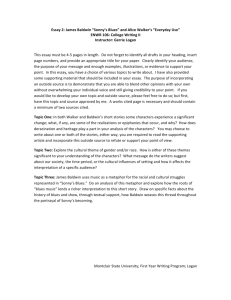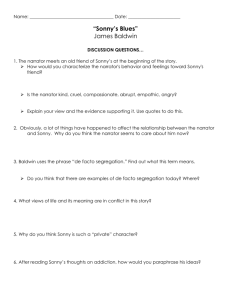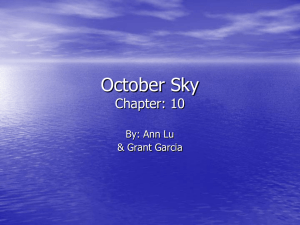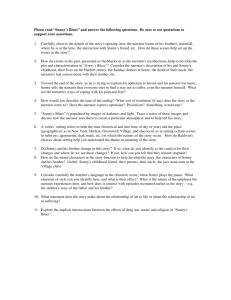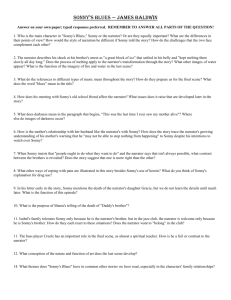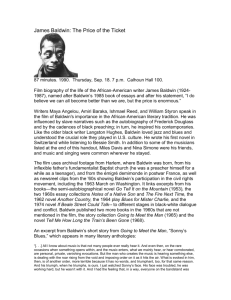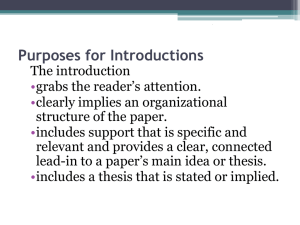Title: Troubled reading: “Sonny's blues” and empathy Significance of
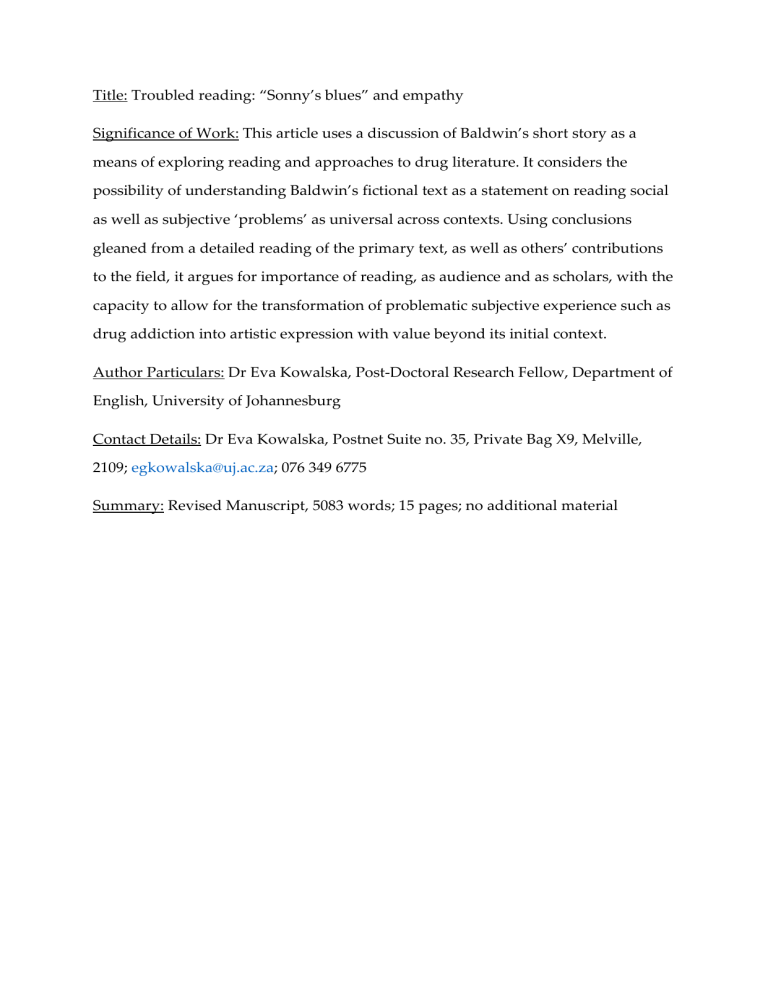
Title: Troubled reading: “Sonny’s blues” and empathy
Significance of Work: This article uses a discussion of Baldwin’s short story as a means of exploring reading and approaches to drug literature. It considers the possibility of understanding Baldwin’s fictional text as a statement on reading social as well as subjective ‘problems’ as universal across contexts. Using conclusions gleaned from a detailed reading of the primary text, as well as others’ contributions to the field, it argues for importance of reading, as audience and as scholars, with the capacity to allow for the transformation of problematic subjective experience such as drug addiction into artistic expression with value beyond its initial context.
Author Particulars: Dr Eva Kowalska, Post-Doctoral Research Fellow, Department of
English, University of Johannesburg
Contact Details: Dr Eva Kowalska, Postnet Suite no. 35, Private Bag X9, Melville,
2109; egkowalska@uj.ac.za
; 076 349 6775
Summary: Revised Manuscript, 5083 words; 15 pages; no additional material
Troubled reading: “Sonny’s blues” and empathy
The focus of this article is a discussion of the short story “Sonny’s blues” by
James Baldwin, with emphasis on the author’s positioning of the reader and narrator in relation to the subject of the story. I argue that Baldwin’s construction of a vantage point of critical empathy, which he models as a mode of engagement with the
‘troubled’ content of the text, is instrumental to his figurative explications of the potential redemptive value of art in relation to hardship.
I use the observations made in this analytical discussion to make some points about modes of reading texts, such as this one, which are concerned with the often ineffable and alienating experience of heroin addiction. I also posit the possibility of using a work of fiction to articulate a critical approach by allowing a literary text to speak of itself, for itself, and possibly of and to other texts beyond that. The idea is of including the creative into scholarly reading, rather than imposing a purely theoretical framework onto writing which is already fully aware of and articulate about its underlying convictions and compromises. In this light, I invoke critical work on Baldwin’s construction of community in this and his other works of fiction.
I duscuss his use of the blues as metaphor for the expression of individual suffering and communication of collective sorrow. I also discus the functions of alterity in terms of (sub)culture, race, subjectivity and interpersonal relationships in the text.
Baldwin is known as much for his novels, which include Go tell it on the mountain
(1953), Giovanni’s room (1956), Another country (1962) as for his several collections of essays. However, it is in the short story format that his writerly agility is best matched to a perhaps slightly polemical concern with a spectrum of recurrent themes, notably masculinity and black identity within American literary culture.
‘Sonny’s blues’ was first published in the Partisan Review in 1957, and later as part of a collection titled Going to meet the man in 1965. In this short story Baldwin explores the possibility of an artistic value emergent from drug use and the social
1
and personal problems it engenders. While it is a relatively dated text, given that literature dealing with drugs and their users has changed substantially in style and stance since its time of writing, it remains significant. It is also valuable in the sense of being a statement on literature dealing with the dynamics associated with drugs, as well as the possibility of reading such work with empathy in order to gain insight.
Bladwin strongly suggests in this story that it is through empathy that the aesthetic experience of a text can be fully accessed.
In the story the unnamed narrator attempts to come to terms with his brother
Sonny’s heroin addiction. Being an addict is intimately tied up with Sonny’s being a jazz musician and his disrupted adolescence in Harlem. The older brother’s need to understand Sonny, however, is enabled by his own problems, especially the death of his young daughter. In a way it is the uncontrollability of loss which leads him to discover his brother’s own responses to unpredictable sorrow and need, through both drug addiction and music. Sonny’s expression of his experience resonates with many other elements in the text, suggesting a redemptive integrity.
The death of the child, named Grace, symbolises the loss of grace which befalls Sonny. Quite literally, the loss of Grace also enables her father to empathise with and explore the emptinesses and aches of others. There is a suggestion, however, that Sonny, a metaphorically lost child, might yet regain or reclaim a state of grace through his music. Through the connotations carried by his name, his thematic and structural placement in relation to Grace the child as well as the state of grace, and his function as socially liminal sufferer and agent of redemption, Sonny also becomes readable as a Christ figure.
Sonny’s youth sets the tone for his adulthood. Even though he is better understood as he gets older, he is not more easily understandable. He manages to maintain his abstinence, but he has always once been an addict. While his musical ability coupled with his intuition in the medium is redemptive, the space in which this transformative, expressive musicality is performed is not particularly accessible.
2
Sonny is not demanding; rather he is provocatively elusive, generally troublesome.
Sonny’s adolescence contains a resonance with his later self and prefigures his drug use. It holds the duality of his later grace and fallenness, sorrow and splendour, at once creative beyond his own uses and frustratingly self-destructive. He is described in such terms as: ‘it was as though he were all wrapped up in some cloud, some fire, some vision all his own; and there wasn’t any way to reach him’ (187). The precision of Baldwin’s diction is revealing – Sonny’s state is ‘as though’ something, rejecting concrete terms, difficult to describe beyond speculation. We know only how he seemed; but we know for a hard, cold fact that ‘there wasn’t any way to reach him’.
In the opening of the text, Baldwin withholds the details of what has happened and builds up the narrator’s anxiety with the words: ‘I was scared, scared for Sonny. He became real to me again’ (170). But despite its being almost overwhelming, his response seems delayed. He cannot maintain his denial at the news that, as he matter-of-factly puts it, ‘[Sonny] had been picked up, the evening before, in a raid on an apartment downtown, for peddling and using heroin’ (170).
Despite his shock and fear, he remains at work, teaching all his classes, and afterwards, when he allows himself to consider what has happened, he still does not act, and only writes to Sonny months later. This delay or ‘lag’ lasts throughout the story, and description only catches up with events at the end of the text in an immersive narrative immediacy.
At the same time, however, he carries certain expectations of what his brother’s addiction means; he is familiar with it from the outside. He says: ‘I didn’t want to believe that I’d ever see my brother going down, coming to nothing, all that light in his face gone out, in the condition I’d already seen so many others’ (170).
Although it takes him the length of the story to understand its specific hold on
Sonny, he is already aware of the circumstances which might drive a young man into heroin abuse.
3
The motif of music is part of the broader Harlem idiom Baldwin employs, and which is encountered in several of in his novels and short stories. Specifically, the blues as written by Baldwin links together past and present, memory and reality, sorrow and desire, strangeness and familiarity. The narrator, alone in his empty classroom, listens to the disjointed but coherent sounds of the schoolboys outside, and muses: ‘perhaps I was listening to them because I was thinking about my brother and in them I heard my brother. And myself. One boy was whistling a tune, at once very complicated and very simple, it seemed to be pouring out of him as though he were a bird, and it sounded very cool and moving through all that harsh, bright air, only just holding its own through all those other sounds’ (171). This foreshadows what Sonny will do at the end, his musical ability and struggle to ‘hold his own’. It also announces the narrator’s ability to listen, and willingness to find beauty in the tenacity of the tune.
Music, particularly in incongruent or unforgiving circumstances, appears at some of the text’s most difficult moments. When he is younger and already troubled
Sonny is said to be ‘at that piano playing for his life’ (187). Thus when it is revealed as such, Sonny’s music is acceptable as the counterpart to his addiction, a glimmer of life within the desperation of his situation. By contrast, Grace’s death is signalled by an absence of sound around her. The narrator describes how Isabel, his wife, ‘heard
Grace fall down in the living room. When you have a lot of children you don’t always start running when one of them falls, unless they start screaming or something. And, this time, Gracie was quiet. Yet, Isabel says that when she heard that thump and then that silence, something happened to make her afraid’ (189).
The tender way in which the narrator explains his wife’s experience suggests a complete intimacy of knowledge between them. This composite retelling of a tragic loss is profound on a metaphorical level within the story as well. The fall of grace, initially a sort of innocence linked to the twilit memories of childhood, is so profound as to be audible to the human ear; but the anger, fear and grief of that fall
4
are silent, silenced. The child, yet to be diagnosed with the polio that kills her, cannot scream to signal her distress. It is the silence that brings her mother running, and that remains the parents’ anguish. The loss of grace is the loss of voice, of sound. It is a vacuum which Sonny, as significantly and dually named as his niece, at once a perennial boy child and a ray of sunshine, fills with his own coping mechanism, his struggle, his complex self.
Sonny is sound: an arrangement of sound so expressive that he eventually allows, in a profound moment of enlightenment in a darkened cellar nightclub, his brother to feel that he can make sense of not just his own suffering and joy, but of these emotional experiences on a universal human level. Sonny’s relationship to music is as essential; it is as melded into his identity and being as his relationship to heroin. Absorption of this kind precludes meaningful action, and accordingly Sonny only moves to make intelligible, insightful music of his profound, obliterating sound once rehabilitation forces him to shed his addict identity. This is a crucial element which enables fulfilment and closure at the end. For all his deviance, Sonny is not disregarded. While the experience of him as a youth was that ‘it wasn’t like living with a person at all, it was like living with sound. And the sound didn’t make any sense’ (187) when allowed to mature through experience, to be shaped through the sorrow and indignity of heroin and its withdrawal, as well as the constant vigilance of abstinence, it does have meaning. Sonny proves his maturity when he can sound his niece’s voicelessness, and her parents’ grief, along with his own torment. The narrator is able to complete his tale when he translates that sound into words.
This non-verbal eloquence is placed in contrast to the faltering, unsatisfying conversations of the text. Writing in 1971, in a context cognisant of Baldwin’s immediate audience, Elaine Ognibene terms one such instance ‘a classic dialog[ue] of non-communication’ (Ognibene 1971: 37) and suggests that the narrator, through his middle class (and therefore, at the time, implicitly white) aspirations has ‘deafened himself to his brother’s voice’ along with ‘the sights and sounds of the ghetto’
5
(Ognibene 1971: 37). This is perhaps an unfair division of blame, considering that
Sonny rarely speaks at all unless provoked; but it is clear that throughout the text, the two men mostly talk past each other.
As the story draws towards its conclusion, the narrator observes as Creole, a fellow musician, guides Sonny towards his self-expression and then ‘stepped back, very slowly, filling the air with the immense suggestion that Sonny speak for himself’ (198). This suggestion is immense on a number of levels. It suggests the other musician’s intimation of Sonny’s ability, his capacity to transform what he knows into musical form. It suggests also that Creole knows, having, by implication, experienced ‘trouble’ similar to Sonny’s, the depth of self accessed through, amongst other things, drugs. He is also, it seems, familiar with immersion in creativity, loss such as the narrator’s, and other fundamental experiences collectively thought of as
‘trouble’ in the parlance of the story. Furthermore, Creole seems to know that he can only guide Sonny so far, and then he must let him express his loss and desire himself, for it is both universal and unique. Like other musicians in Baldwin’s work, notably Arthur in the much later Just above my head (1978), it is imperative that Sonny
‘cultivate his own voice’ (Shin & Judson 1998: 256). Significantly, these authors also identify the acquisition of the ‘understand[ing] that redemption lies interconnectedness’ (Shin & Judson 1998: 257).
In the context of what Sonny and Creole and the other musicians are doing, the idea that fundamental experiences can be expressed non-verbally, can be
‘spoken’ in a different form, is quite profound. It is also a provocative suggestion in terms of the story’s message which maintains, through the narrator’s love for Sonny and desire to understand him, that people like him are not hopeless, wasted beings.
Instead, the ‘immense suggestion’ of the story is that they might yet have something to say, and they should be listened to.
The passage that best illustrates this central concern of value redeemed through suffering is presented as the climax of the story. Hearing Sonny play, the
6
narrator realises the interpersonal and artistic space Sonny has entered, and for all his disdain of jazz, the older brother understands it very well. This is how he perceives the instrumental ‘dialogue’ between Sonny’s piano and another player,
Creole’s, fiddle:
He was having a dialogue with Sonny. He wanted Sonny to leave the shoreline and strike out for the deep water. He was Sonny’s witness that deep water and drowning were not the same thing – he had been there, and he knew. And he wanted Sonny to know. He was waiting for Sonny to do the things on the keys which would let Creole know that Sonny was in the water.
(197)
In Tracey Sherard’s description, ‘he is answering and commenting, coaxing the others, including Sonny, to use their history to comment on the musical forms which contain it’ (Sherard, 1998: 703). Because of the space in which to develop such a conversation, the unspoken but manifest shared knowledge of the ‘deep water’ of life, of heroin, and of music, Sonny can venture into it and return. In doing so he reconciles his need to be in the world and his tendency to, as he puts it ‘shake to pieces’. The narrator says that ‘Sonny went all the way back, he really began with the spare, flat statement of the opening phrase of the song’ (198). Immersing himself in the metaphorical manifestation of his brother’s experience, he finally understands, and interprets what he hears for the reader. Baldwin seems to accompany him, drawing attention to the transformed stylistics of the text from the ‘spare, flat statement’ of its own opening phrase, which is ‘I read about it in the paper, in the subway, on my way to work’ (170) to the poetic confidence and strength of then he began to make it his. It was very beautiful because it wasn’t hurried and it was no longer a lament. I seemed to hear with what burning he had made it his, with what burning we had yet to make it ours, how we could cease lamenting. Freedom lurked around us and I understood, at last, that he
7
could help us to be free if we would listen, that he would never be free until we did. (198)
The essence of Baldwin’s story is the creative production engendered by personal suffering, in the form of drug addiction, as being most meaningful and beautiful when it engages a particular genre of music, jazz. This is a significant and appropriate choice given its social, cultural and historical presence. Jazz couples a historical archive with immediate, improvisatory expression, which carries within itself numerous associations between subculture, art, life, and frequently, drug use.
The blues, as it is rendered in Baldwin’s text, is concerned with experience and its representation. Reilly notes that Baldwin’s use of ‘the Blues as a key metaphor’ in the text harnesses its potent ‘combination of personal and social significance in a lyric encounter with history’ (Reilly 1970: 56). Although Reilly’s work on this text is, like
Ognibene’s, dated and not unproblematic, it is potentially more attuned to capturing the immediacy of the story and response in its original context. Both critical texts offer a perspective which is historically different, and thus valuable when considering the work fiction might do.
Jazz seems to be the most appropriate way for Sonny to voice his troubled sense of self. It functions as the figurative, creative language which, as a medium, is truest to its raw material. As Douglas Taylor notes with regard to another of
Baldwin’s works featuring a jazz musician, Another country , it is for him a form best suited to the expression of yearning, of the full extent of not having. ‘Instead of representing Jazz as the music of pleasure and immediacy, Baldwin shows how a fundamental lack lies at its core’ (Taylor 2010: 93). However, the moment of perfect expression such as experienced in the text takes place on a meta-textual level as well.
Baldwin allows the content of story and the praxis of its writing to come together at the end, amplifying the completeness and synergy of the narrative climax.
In exploring the strategies and meanings of the story as a ‘blues text’, Sherard points out that jazz, especially of the sort favoured by the younger Sonny,
8
‘represents a revision of the blues that allows for commentary on the disappointing economic and social conditions of African American urban culture – in “Sonny’s
Blues”, specifically, the conditions of Harlem’s ghetto’ (Sherard 1998: 693). She further observes that ‘Baldwin’s story ultimately signifies on, or repeats with a difference, the function of the blues as relating the history of Black culture in
America in order to argue for a critical awareness among African Americans of the historical contexts of their own cultural forms’ (Sherard 1998: 691). While the reading of such a musical ‘metanarrative’ in the text is certainly accomodated, Sherard disregards the other major element informing the text – that of a drug narrative with an inverted redemptive ending. In dismissing the insightful innovation of Baldwin’s changing the ‘dead-end plot’ (Sherard 1998: 695) of the heroin-in-Harlem narrative to a tale of redemption through immersion and community through acceptance,
Sherard relagates this crucial aspect of Sonny and all that he stands for to the nonstatus of ‘ghetto dynamic’ (Sherard 1998: 694).
In ‘Sonny’s blues’ Baldwin employs the vantage point of the outsiderobserver invested in knowing the addiction of another, and thus facing the familiar alterity of drug use. Baldwin combines his narrator’s perspective and the inflection of memory with factors influencing and informing Sonny’s habitual abuse of heroin, indicating that causes and effects are not clear and discrete, but intermingled and complex. These themes, running throughout the story and consolidated at its end, include the interplays between nostalgia and memory, loss and acceptance.
The role and nature of the narrator are of structural importance. Ognibene identifies the narrator as ‘the respectable schoolteacher, the ‘white’ Negro, Sonny’s big brother’ who ‘though older, is not wiser’. She suggests that Baldwin ‘uses both
Sonny and his music as tools to help’ the seemingly “together” narrator accept and tell the story of his own identity, which entails ‘reconcil[ing] himself to his racial heritage’ (Ognibene 1971: 36).
9
While the narrator maintains a useful proximity to Sonny, the sense of intimacy and understanding between them is built up on the shaky foundation of their damaged relationship as the narrative develops. The narrator’s name is never revealed, reinforcing that the subject of the story is Sonny’s musical expression, as the title indicates, and not the telling of the brother’s tale. Arguably it is the formcontent relationship between the two which is really the point of the text. This is amplified by the framework of fraternity in which identity with its ‘trouble’ is worked out. The brother’s easy familiarity and seeming reliability are complicated by his namelessness, particularly as naming is so meaningful in the text. This also allows him to be an ideal stand-in for the reader, facilitating access into the story, making a statement about point of view and proximity, as well as deftly manoeuvring the reader into the most vulnerable and instructive vantage point as the narrative builds momentum.
The reader is encouraged to identify with the narrator, but at the same time,
Baldwin’s use of the term ‘trouble’ functions to denote a universal experience, making Sonny’s solitary problem of addiction more comprehensible through comparison to other more common experiences. Baldwin creates the opportunity for empathy with the troubled and troubling character as well as his more forthcoming brother. This is made more challenging, perhaps, by Baldwin’s clear refutation of the predominant stereotypical ideas around addiction and its counterparts. Thus while the story makes mention of the difficulties of simply growing up and maintaining an identity as a young black man in the American city at mid century, as well as the more specific troubles and multiple losses faced by Sonny and his family, it does not entertain the notion of these circumstances directly resulting in Sonny’s drug abuse as a mode of escapism. Even more explicitly, Baldwin negates the notion of a romanticised self-destructive creativity, or a trade off of stability for art. To make this point he has Sonny himself insist, in a rare moment of candour, that his heroin use has no bearing on his ability to play, by which he seems to mean his ability to
10
improvise and create more than just his mechanical dexterity. Reilly again points out the significance of blues as appropriate vehicle for the message of the story by stating that as a genre ‘it is popular rather than elite, worldly rather than otherwise.
The Blues is expression in which one uses the skill he has achieved by practice and experience in order to reach toward others’ (Reilly 1970: 59).
Addiction, although it is the story’s main concern, is not a singular, anomalous affliction in it. By refusing to cut it off from these ties, to abandon it, as his narrator initially would want to do, Baldwin, while far from condoning heroin abuse, acknowledges its reality within the scope of human experience. Baldwin’s characters live with and through each other, and Sonny’s addiction constitutes the same constant threat of re-opening the ‘mortal wound’ that Isabel’s grief for her child is to her husband.
Trouble, even the alienating and shameful trouble of addiction in the context of the story, is bound up with the troubles of others. Although in it transcendence – of the world through drugs, or of drugs through endurance, of suffering through its expression into beauty – is solitary, understanding and community are not, and grace is about listening as much as playing. The effort on the brother’s part is matched by Sonny if one considers that, for all his talent, his playing is a means of working through the very private, antisocial impulse of his addiction. As Hussey points out, ‘one of the reasons why heroin is still taboo is that it wipes away the sense of responsibility to the collective, to the herd. That is why users are usually characterised as self-destructive narcissists who don’t really deserve to survive their habits’ (Hussey 2013: 11). This harsh appraisal is not far off the mark in terms of social perception, and the time span between Baldwin’s story and Hussey’s article indicate how little has changed in this regard.
All of this brings to the fore Baldwin’s considerations of subjectivity, which is never a clearly defined, extractable aspect of his texts, but is subtly enmeshed in the fabric of his narratives. This formal embedding of a central theme serves to illustrate
11
the extent to which subjectivity is formed by an interplay of influences. It also reinforces the notion that each of Baldwin’s characters, in this text as well as in his other fictions, carry these influences about them in every encounter of the world, and expression of self within it. Baldwin’s writing this consideration into small but significant markers of subjective space in the text works as a reinforcement of content through form. Thus ‘Sonny’s blues’ ‘not only tells a story; it is about the telling of stories’ (Sherard 1998: 692).
To some extent, the narrative and its characters can be seen as microcosmic of greater contextual as well as literary issues. Textual subjectivity is a necessarily selfconscious construct, not a reflection of any reality. Rather, it is a reproduction made to show its machinations. It does so especially at its limits – we know of Sonny only through what is revealed to and then by the narrator. We feel we know the narrator, but are denied even the most basic details of his identity. The text bears also an intersubjectivity beyond these limits, through its insistence on the reader’s empathy, its intertextual relationship to Baldwin’s other texts, as well as its concerns which are shared with other textual communities. Sonny’s interiority is unknown, save for the fact that it is at the centre of the text. Yet it, rather than any of the other elements of the story, potentially transcends its textual boundaries.
Avital Ronell writes in Crack wars , a meditation on the role and representation of drug abuse in Western culture, that ‘a work, no matter how recondite, specialised, or antiquarian manifests a historical compulsion’ (Ronell, 1992: 21). Even texts far more obscure than Baldwin’s, which still speaks with remarkable poetic clarity to a contemporary readership, mark a literary historical place and gesture at a stance in relation to their context. Most texts do more active work than this minimum set by
Ronell. They are at the very least manifestations – in this case, of the reworking of a pattern into a vital expression of life, Baldwin’s feelings about his subject matter, which speak to and about the space in which he writes. But, Ronell states, the postmodern reader is of a different time. ‘We no longer exist in a way that renders
12
manifestation possible: we have lost access to what is manifested, even to manifestation itself’. The only thing we make manifest is ‘the fact that humanity is not yet just’ (Ronell 1992: 21).
The notion of ‘trouble’ is presented by Baldwin as being both individual and universal. It is understood as being a form of suffering which can perhaps be rendered meaningful if it can be transformed, worked through, expressed, by the character of Sonny in the story, or by Baldwin in the writing of it, or the reader in accepting it. Through the accessible but defined space the narrator’s voice creates, the reader is enjoined to encounter and be part of this dynamic, to partake of the story at least so much as to understand and appreciate its structural parts coming together at the end, as the brother finally understands, without words, not the substance, but the state of Sonny’s trouble with heroin.
In an article titled ‘The bridge of suffering’ (1983) Dorothy H. Lee explores
Baldwin’s construction of community, both specific and universal, in his work. The theme of ‘Sonny’s blues’, she points out, is shared across much of Baldwin’s writing,
‘all of’ which, she argues, ‘is spun out of suffering’ (Lee 1983: 92). In its use of taboo behaviour and strife to overturn stereotypes and argue for redemption through sheer creative expression as having sufficient value of its own accord, the makes a daring argument, which is rendered compelling because of the way it is presented.
Lee approaches the notion with a sympathetic phrasing, suggesting the
‘capacity for pain’ by which Baldwin’s characters are distinguished (Lee 1983: 92).
This capacity also pertains to his readers, and the implicit requirement of ‘Sonny’s blues’ is for the reader to make space within their consciousness for the character’s troubled experience. This is what the narrator himself accomodates, through a series of subtle changes not explicitly expressed, but made clear by contrast if one considers that his initial response was: ‘I couldn’t believe it: but what I mean by that is I couldn’t find any room for it anywhere inside me’ (170). Lee doesn’t hesitate to include the reader in the redemptive possibility of Baldwin’s work, and suggests
13
that ‘he clearly conceives that out of the bonding consequent to vicarious suffering, character to character and reader to character, will come salvation’ (Lee 1983: 92).
For Baldwin understanding on an emotional level, rather than just intellectual engagement, is crucial to aesthetic appreciation. This story seems to accordingly play out the idea that the willingness to persist in trying to understand is key to hearing the one important solo, and that its beauty can only really be experienced through empathy – through the brother’s acknowledging anguish of his own. The implication, the ‘immense suggestion’ that Baldwin puts forth in this work, is that reading can and should engage the troubled text with the same degree of patience and empathy in order to see it work as it should.
Acknowledgements
I would like to thank Michael Titlestad who supervised the research which eventually became this article.
Keywords
Baldwin, drug literature, critical empathy, literary representation of music, blues in literature, form-content relationship, short story studies
14
References
Baldwin, J., 1992 (1957), ‘Sonny’s blues’ The Granta book of the American short story
Granta, London
Hussey, A., 2013, ‘Heroin: art and culture’s last taboo’ Guardian 22 December 2013
[online edition]
Lee, D.H., 1983, ‘The bridge of suffering’ Callaloo 18, 92-99
Ognibene, E.R., 1971, ‘Black literature revisited: “Sonny’s blues”’ The English Journal
60. 1, 36-37
Reilly, J.M., 1970, ‘”Sonny’s blues”: James Baldwin’s image of black community’
Negro American Literature Forum 4.2, 56-60
Ronell, A., 1992, Crack wars: Literature, addiction, mania University of Nebraska Press,
Lincoln, Nebraska
Sherard, T., 1998, ‘Baldwin’s “blues text” as intracultural critique’ African American
Review 32.4 , 691-705
Shin, A. & Judson, B., 1998, ‘Beneath the black aesthetic: James Baldwin’s primer of black American masculinity’ African American Review 32.2, 247-261
Taylor, D., 2010, ‘Three lean cats in a hall of mirrors: James Baldwin, Norman
Mailer, and Eldridge Cleaver on race and masculinity’ Texas Studies in Literature and
Language 52.1, 70-101
15
